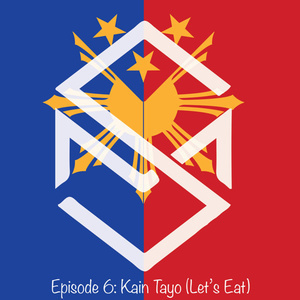How’s that tagline sounding? Still testing it out! Welcome to Episode 8 of the podcast: Kain Tayo Part Two: Let’s Eat!
Before we get to the food talk, some tech adventures:
- Shout out to Jeff (@JeffBanas on Twitter)! He sent me a recording of my podcast playing on his Google Home – awesome!
- Amazon Echo (Alexa): Got curious and tried Alexa… (audio clip of Alexa failing) …yeah, no luck initially. It seems Alexa uses the TuneIn directory. I’ve submitted the podcast there now, but Alexa still couldn’t find it when I tried again. Maybe I need to subscribe via the TuneIn app first? If you have an Echo, let me know if it works for you! (Apologies if I triggered your devices!)
- Siri: Good news here! After a few tries (Siri can be quirky!), it successfully played the latest episode directly from the iOS Podcast app. (audio clip of Siri success) So, if you’re on iOS, just ask Siri!
Recording Challenges & Episode Topic Shift
This episode almost didn’t happen! I struggled with my original topic idea all week, decided to switch gears back to food (continuing from Episode 6), recorded this “Kain Tayo Part 2″… and then accidentally deleted the recording! Ugh. So, this is take two, fueled by a stout, hopefully, I don’t mess it up again!
Deeper Dive: Kain Tayo Part 2
Let’s continue exploring Filipino eating habits and culture!
Your Plate: Kanin, Ulam, and Maybe Soup?
A typical Filipino meal plate breaks down simply:
- Kanin: Rice (the staple!)
- Ulam: The dish(es) or viand(s) eaten with the rice. You can definitely have more than one ulam!
Sometimes, you’ll also have soup alongside your meal:
- Sinigang: A delicious, distinctively sour soup (often with fish, shrimp, or pork).
- Nilaga: Another type of soup, not sour. Often, you might just get the broth (sabaw) to pour over your rice.
From Field to Plate: The Journey of Rice (Palay, Bigas, Kanin)
There are three main stages in the life of rice:
- Palay: This is the harvested rice grain still in its yellowish-brown husk. After harvesting from the wet rice paddies, it needs to be dried. In the Philippines, lacking dedicated drying spaces, farmers often lay palay out on the roadsides (so drivers need to be careful!). Once dried, it’s placed in a bilao (woven tray) and tossed/shaken to loosen the husk and remove debris.
- Bigas: This is the uncooked rice grain after the husk has been removed – what you typically buy in a bag.
- Kanin: This is the final stage – cooked rice!
How We Cook Rice (Jo Koy & The Finger Trick)
Speaking of cooking rice (bigas to kanin), comedian Jo Koy has a hilarious bit about this (I’ll link it below). The typical “Filipino” way, even with a rice cooker, involves:
- Washing the bigas several times (3-4 rinses) until the water runs mostly clear.
- Measuring the water level using the lines on your finger! (Yes, it works! Takes practice to avoid soggy or crunchy rice, but I’m proud to say I can do it). Of course, back home, many people expertly cook rice in a pot over an open fire – true pros!
(Link Placeholder: [Insert Jo Koy Rice Video Link Here])
Appetizers: When Do They Arrive?
Unlike typical Western dining, appetizers in Filipino settings aren’t always served before the main course. Very often, they arrive with the ulam and kanin. My theories?
- Appetizers aren’t a standard part of the meal structure for us.
- It ties back to the salo-salo concept – the idea that everyone should start eating together. Serving appetizers first would mean some people eat while others wait. You can usually request appetizers first if you want them, though.
Must-Try Filipino Desserts
We love our sweets! Here are a few common Filipino desserts:
- Halo-halo: A popular concoction of crushed ice, milk/cream, sweet beans, fruits, sago/boba, ice cream, and leche flan. So refreshing!
- Leche Flan: Rich, creamy caramel custard. Also a component in halo-halo.
- Ube: Purple yam, used as a popular flavor in ice cream, cakes, pastries, etc.
- Turon: A deep-fried treat resembling an egg roll, but filled with banana and lanka (jackfruit). Sometimes dipped in sugar – so good! (Yes, our love for sweets might contribute to diabetes struggles in the community.)
Fast Food Perks: No Cleanup Needed!
Here’s a difference you’ll notice: In fast-food restaurants in the Philippines, you don’t typically clear your own table and throw away your trash. Staff will come and clean up after you leave.
Funny Story: On a trip back in 2005 with my friends Jeff and Irwin (their first time there), after eating at a fast-food place, Irwin got up and started wandering around looking for a trash can. Jeff and I just watched him, knowing the routine. After a good 30 seconds of confusion, he came back asking where the trash was, and we cracked up explaining he could just leave it!
Salo-Salo: Sharing is Caring (Literally!)
Revisiting salo-salo from Episode 6: It’s not just eating together, it’s often about sharing the food ordered. If a group orders different dishes (ulam), it’s very common to portion out servings from each dish onto everyone’s plates before anyone starts eating their main meal. It’s a great way to try everything! This communal sharing is a key part of the experience.
Paying Up: Mastering the “Cheat” Gesture
Finally, how do you ask for the check/bill in the Philippines? Forget the American “cut me off” gesture. We have our own unique hand signal! The word sounds like “Cheat” (maybe slang for ‘check’?).
How to do the “Cheat” gesture:
- Make loose fists with both hands.
- On each hand, extend your thumb and index finger to form a ‘C’ shape (left hand ‘C’, right hand backward ‘C’).
- Touch the tips of your index fingers together and the tips of your thumbs together, forming a rectangle shape in the air (representing the bill).
- Get your server’s attention while holding this shape.
- Slowly pull your hands apart horizontally (drawing the top/bottom lines).
- Move your thumb and index finger on each hand vertically downwards towards each other (drawing the sides). Basically, you’re drawing a rectangle in mid-air! Servers in the Philippines (and Filipino restaurants here) instantly recognize this. My friends Jeff and Irwin loved it so much on our trip they kept fighting to pay just so they could do the gesture! (Trying it at a non-Filipino US restaurant got them a to-go box once!). Pros can even do a one-handed version.


